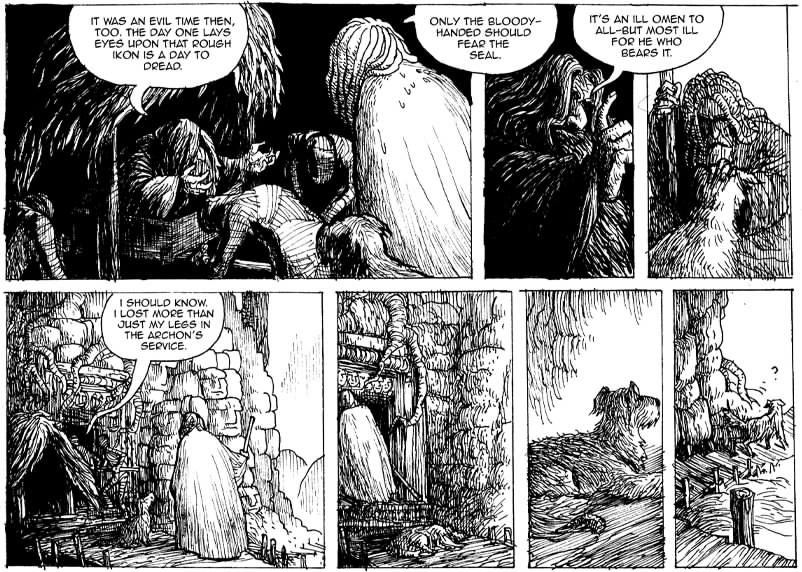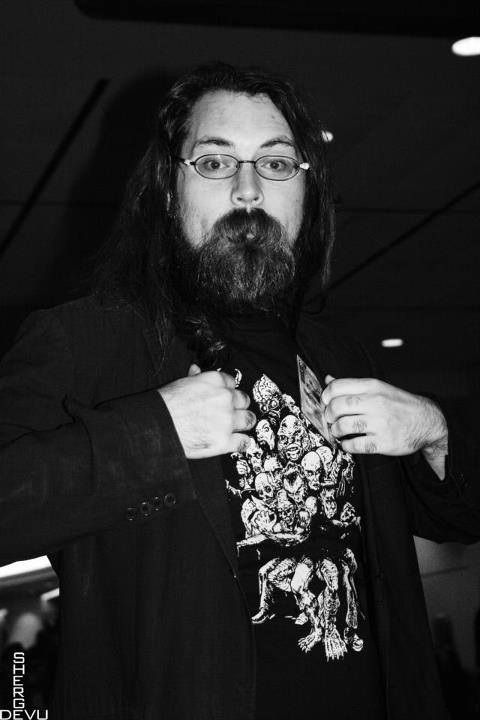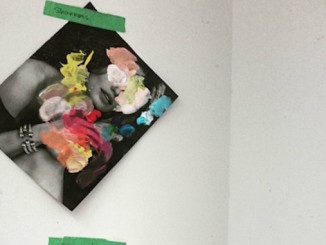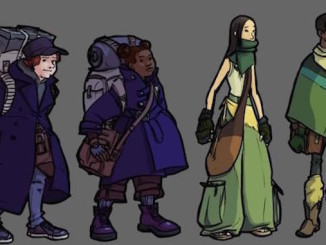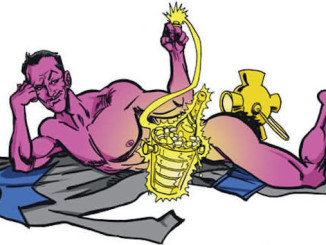Artist Chris Huth’s intricate illustrations are often inspired by the darker realms of fantasy. As likely to create a finely wrought homage to Lovecraftian horror as a tongue-in-cheek ode to pulp science fiction, Huth’s work is characterized by exquisite attention to detail, fine line work and a black sense of humour. As comfortable collaborating on web comics as he is providing illustrations for role-playing games, Huth is an active and open-minded collaborator.
Describe your style and focus. What defines you as an artist?
I’m not sure I want to be defined as an artist. I’m certainly not aiming for any particular style or idiosyncratic look. I’d actually prefer to be complete artistic cypher, someone capable of forging perfectly any other art or artefact you see. Not that what I end up doing is remotely close to that; a personal style is inevitable, I guess.
Many of your pieces are horror-, sci-fi- and fantasy-themed. What draws you to these subjects?
The *world* is horror-, sci-fi- and fantasy-themed. I just happen to like those parts more than others. The distinctions between each part, as well, is more a function of marketing than a reflection of some sort of essential difference—trying to find a real, functional difference ends with a small idealized core sample of each and wide borderlands of fuzziness. The borderland of fuzziness is where I hang out.
The common denominator of all of the things I like—which includes stuff that doesn’t really inform my art, I guess—is a preference for places in which the boundaries, rules, definitions and identities of things and people are absent, altered, mutating, or there to be transgressed. Fantasy and horror is about the shock of violation of human expectations. In fantasy, the expectations are about the physical environment; horror, moral or behavioural expectations; sci-fi is about trying to come to terms with a world defined by new or alternate rules. I’m also a big fan of psychological thrillers, the grimmer and more lo-fi espionage fiction, nonfiction about fringe or hidden societies, and the cosmic grab-bag that ends up in the pages of Fortean Times. When I talk about it in casual conversation, I just usually say ‘weird crap.’
What mediums do you prefer to use? Do you prefer to work on paper or digitally?
I generally like working in pen and ink best (see #4) but being in The Future and all I’ve come to appreciate Photoshop and some of the things only Photoshop can do—’digital paintings’ are sometimes closer to digital printmaking in process. Nothing beats watching ink on bristol board dry, though.
Your work is often incredibly dense and intricate. What caused you to become so focussed on detail?
I’m nearsighted—that’s probably all there is to it. I started drawing with my nose an inch from the page and become very aware of how much detail you can pack into a square inch.
What images do you find the most sublime? What kinds of images disturb you?
Sublime is a hard word to append to an image produced by human hands. The last time I saw something and got really blown away was “St. John Chrysostom and the Empress Eudoxia” by Jean-Paul Laurens, with its combination of textural richness and the depth of suggested narrative.
Disturb is also a hard thing to put in. Deer really freak me out. It’s the eyes. In light of number 2, though, I’m not sure I’d draw much of a distinction between a profound sense of disturbance and sublimity.
What do you love to draw?
Like with food, I’m drawn to interesting textures and things with complex negative space. Old people, old buildings, ruins, sea life, bugs. Swarms of bugs. History. The four-dimensional object that is expressed in the macro as urban environments and the micro as veins, bones and organs and somewhere in between as the artefacts of culture.
There’s a military term: ‘human terrain.’
What have been the most successful and positive collaborations that you have done so far?
I’m not sure I’d use ‘collaboration’ to describe anything I’ve done. I work with writers and editors, and I think of them as clients, and I go to other artists for critiques while working on things, but a big part of wanting to work on something is feeling that I own it and are fully responsible for it myself—whether that’s interpreting or adding value to someone’s text or producing an image which stands next to another artist’s.
After that caveat, though, I’m not sure I can point to any one thing without pulling out more caveats, and more problems with each. My art is my children—like all children, they’re flawed, imperfect beings you love despite their failure to live up to your high standards. As Tolstoy said, each unhappy family is unhappy in their own way, and an artist’s studio is never quite a happy home.
What do you think defines a successful collaborative relationship, and how does working with another writer or artist enhance your own work?
The foundation of any collective endeavour that works is trust. Without that, everything you do in the process is politics, not creativity.
Keep in mind, though, the Klingon proverb: Trust, but locate the doors. (Klingons have a lot of things to say about working in creative fields). Not hope, or good-feeling or good intentions or aggressive overuse of the word “Awesome.” Just actual trust which stems from knowledge of who you’re working with. Work for clients you like (and I have the benefit of being a fan of the people I go to for work) and clients whose relationships with *other* artists demonstrates that they’re above board. Do your research.
As for enhancing the work: In visual art, there’s a simple trick that you learn early on. Everyone once in a while, you hold up a mirror to the thing you’re drawing (or, more likely, flip it in Photoshop). Suddenly it’s unfamiliar, and you can see all the horrible flaws in what you’ve done and try to mitigate them. Any extra set of eyes, anything else you can do to make yourself see it new helps you to know what you’ve done wrong, or at least, to know what you could do different.
What are your primary creative goals?
Looking back at item 2, I like to warp expectations and recombine things in new and weird ways. This is just the most cost-effective method. Genetic engineering takes too long, architecture requires building supplies, and mistah Kurtz, he dead, and I ain’t got no pennies with which to take his place.
What are you working on right now and where can we see more of your work?
Right now I’m working on a bunch of roleplaying game illustrations and something for a comic anthology with Rachel Kahn and Kristin Sayer, after just completing illustrations and typesetting for Pelgrane Press‘s new vampires-vs-spies game Night’s Black Agents.
My portfolio is at www.chrishuth.com and frankly I really really need to update it.

